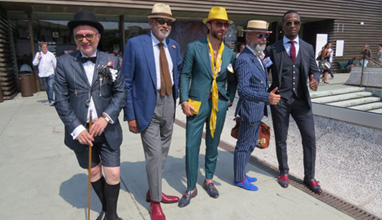History of the men's shirt
The modern men's shirt has a properly long history before acquiring its today's a little boring form in the end of the XIX century. In 1871 Brown, Davis & Co. of Aldermanbury manufactured the first shirt in 'coat style' (with buttons). At first, shirts were put on by being pulled over the head. Since that moment, the shirt was accepted as a top garment.
Till the end of the XVIII century, it was considered underwear and only its collar was visible. Even today it's considered inappropriate a gentleman to take his jacket off if there is a lady in the room - to stay only with shirt is like being dressed in underwear. It is inconceivable superiors to attend a ceremony dressed in shirts.
Till the end of the XIX century the white shirt was an absolute sign of superiority. Only one who has enough money to launder shirts and enough pairs to replace them could afford wearing white shirts. Striped shirts became fashionable in the late nineteenth century, but some viewed them with the suspicion that the color was hiding dirt. Colorful shirts with white collars and cuffs appeared as a compromise. This combination is favorite today, but it doesn't have the venerable seriousness of the white shirt.

The shape of the shirt collar is an essential stylistic mark. Collars of the early shirts are different - in general shirts has either stand-up or turndown collar. The stand-up collar in different variations was the absolute leader till the end of the XIX century. By the 1930s, the stand-up collar - high and rigid - has been progressively replaced by the turndown collar and today its role is to assist tuxedo and tailcoat in their formality. Removable collar (in both variations - stand-up and turndown) was also invented. It has a hygienic advantage - it can be washed separately from the shirt, but this hints about not so big wealth. The real advantage of the removable collar is that it can vary and suggest a number of different mock new shirts. But the annoying morning procedure of fastening and assembling should be also registered.
But there are eccentrics, like popular dandy Tom Wolfe, whose style is very dependent from the attitude of the 1930s and he still wears removable collars and cuffs. And what to say about Karl Lagerfeld's awfully high turtlenecks, which he copied from Count Pückler-Muskau?
The shirt, in its contemporary shape, has changed a little since the end of the WWI. The only novelty is the appearance of a breast pocket when the waistcoat started losing its popularity in 1960s. But a man with a style and conservative beliefs doesn't wear such shirts.
The features of the expensive shirt:
* Small sticks, made of brass, which are tucked into the collar to support its obligate shape.
* The cloth on the back of the shirt, which role is to cover potential asymmetry in a gentleman's shoulders.
* More details, more expensive shirt.
* Matching stripes and checks at the transition from shoulder to arm - optically things should look convincing.
* The strength of the stitches, no matter of they are single needle made or machine made with two needles.
* The back part of the shirt is longer than the front one, to ensure sitting.
* The buttons of an expensive shirt are made of pearl.
* The corner between the front and the back of the shirt is strengthened with a triangular cloth.
* The transition from the sleeve to the cuff comes with many folds and one extra button, which is horizontally positioned.
* Buttonholes and monograms are fully hand-sewn.
Hits: 11105 | Leave a comment



















